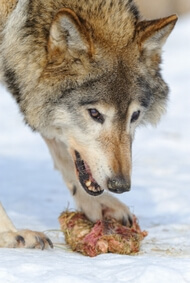A raw dog food diet is designed to mimic a dog’s natural ancestral menu. The whole concept of raw feeding is based upon a dog’s instinctive carnivorous bias — a built-in desire to capture (or find) and eat another animal.
As unsavory as it may seem, it is completely natural for a wolf toconsume the entire animal. Meat, bones, organs and all. As direct descendants of wolves, dogs are simply not genetically optimized to consume the 50% carbohydrate content of today’s commercial kibbles.
So, how do these diets compare?
The Ancestral Diet
Compared to Dry Kibble
No one can argue the dry baked pellets we call dog food aren’tconvenient. Yet the nutrient profile of a dry kibble is nowhere near the nutrient content of a dog’s ancestral diet.

Notice the higher carbohydrate content of the kibble compared to the dog’s natural ancestral diet. Or how about the dramaticallylower protein and fat levels?
The Benefits of a Raw Diet
Feeding a raw dog food diet has many notable benefits…
- Firmer stools
- Improved digestion
- Healthier skin and coat
- Reduced allergy symptoms
- Better weight management
There have been many reports of improved health when chronically ill pets were switched from a commercial product to a raw dog food.
The Downside
of a Raw Dog Food Diet
A raw dog food diet can’t touch the convenience of a kibble. Just measure and pour. It just doesn’t get any easier.
Yet besides the lack of convenience, there’s another critical issue.Bacterial contamination.
Salmonella and E. coli germs can always be a potential problem with raw meats. Yet the risk of food-borne disease is actually quite low.
That is, low risk for dogs. But not for humans.
That’s because a dog’s digestive system is shorter and more acidic.
Which makes canine infections like these fairly rare.
The real risk of food-borne disease is actually greater for a dog’s human caretakers — not the dog.
Yet with proper care and handling, this risk can be dramatically reduced.
How to Use Our List
Below you’ll find a list of the Advisor’s suggested raw dog foods. Of course, this list should not be considered a complete catalog of all the raw dog foods on the market.
For there are others. Many others.
We only provide this small group as a starting point.
As a matter of fact, if you know of a specific dog food you believe we should have included on this list, please feel free to share your recommendations in the Comments section below.
Or if you’re looking for some suggestions yourself, be sure to look through our readers’ Comments to find more good ideas.
Suggested Raw Dog Foods



